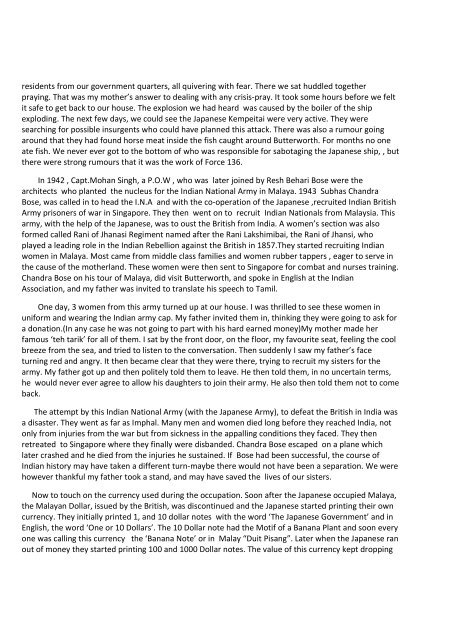Japanese Occupation- Dato' Param.pdf - Malaysian Paediatric ...
Japanese Occupation- Dato' Param.pdf - Malaysian Paediatric ...
Japanese Occupation- Dato' Param.pdf - Malaysian Paediatric ...
Create successful ePaper yourself
Turn your PDF publications into a flip-book with our unique Google optimized e-Paper software.
esidents from our government quarters, all quivering with fear. There we sat huddled together<br />
praying. That was my mother’s answer to dealing with any crisis-pray. It took some hours before we felt<br />
it safe to get back to our house. The explosion we had heard was caused by the boiler of the ship<br />
exploding. The next few days, we could see the <strong>Japanese</strong> Kempeitai were very active. They were<br />
searching for possible insurgents who could have planned this attack. There was also a rumour going<br />
around that they had found horse meat inside the fish caught around Butterworth. For months no one<br />
ate fish. We never ever got to the bottom of who was responsible for sabotaging the <strong>Japanese</strong> ship, , but<br />
there were strong rumours that it was the work of Force 136.<br />
In 1942 , Capt.Mohan Singh, a P.O.W , who was later joined by Resh Behari Bose were the<br />
architects who planted the nucleus for the Indian National Army in Malaya. 1943 Subhas Chandra<br />
Bose, was called in to head the I.N.A and with the co-operation of the <strong>Japanese</strong> ,recruited Indian British<br />
Army prisoners of war in Singapore. They then went on to recruit Indian Nationals from Malaysia. This<br />
army, with the help of the <strong>Japanese</strong>, was to oust the British from India. A women’s section was also<br />
formed called Rani of Jhanasi Regiment named after the Rani Lakshimibai, the Rani of Jhansi, who<br />
played a leading role in the Indian Rebellion against the British in 1857.They started recruiting Indian<br />
women in Malaya. Most came from middle class families and women rubber tappers , eager to serve in<br />
the cause of the motherland. These women were then sent to Singapore for combat and nurses training.<br />
Chandra Bose on his tour of Malaya, did visit Butterworth, and spoke in English at the Indian<br />
Association, and my father was invited to translate his speech to Tamil.<br />
One day, 3 women from this army turned up at our house. I was thrilled to see these women in<br />
uniform and wearing the Indian army cap. My father invited them in, thinking they were going to ask for<br />
a donation.(In any case he was not going to part with his hard earned money)My mother made her<br />
famous ‘teh tarik’ for all of them. I sat by the front door, on the floor, my favourite seat, feeling the cool<br />
breeze from the sea, and tried to listen to the conversation. Then suddenly I saw my father’s face<br />
turning red and angry. It then became clear that they were there, trying to recruit my sisters for the<br />
army. My father got up and then politely told them to leave. He then told them, in no uncertain terms,<br />
he would never ever agree to allow his daughters to join their army. He also then told them not to come<br />
back.<br />
The attempt by this Indian National Army (with the <strong>Japanese</strong> Army), to defeat the British in India was<br />
a disaster. They went as far as Imphal. Many men and women died long before they reached India, not<br />
only from injuries from the war but from sickness in the appalling conditions they faced. They then<br />
retreated to Singapore where they finally were disbanded. Chandra Bose escaped on a plane which<br />
later crashed and he died from the injuries he sustained. If Bose had been successful, the course of<br />
Indian history may have taken a different turn-maybe there would not have been a separation. We were<br />
however thankful my father took a stand, and may have saved the lives of our sisters.<br />
Now to touch on the currency used during the occupation. Soon after the <strong>Japanese</strong> occupied Malaya,<br />
the Malayan Dollar, issued by the British, was discontinued and the <strong>Japanese</strong> started printing their own<br />
currency. They initially printed 1, and 10 dollar notes with the word ‘The <strong>Japanese</strong> Government’ and in<br />
English, the word ‘One or 10 Dollars’. The 10 Dollar note had the Motif of a Banana Plant and soon every<br />
one was calling this currency the ‘Banana Note’ or in Malay “Duit Pisang”. Later when the <strong>Japanese</strong> ran<br />
out of money they started printing 100 and 1000 Dollar notes. The value of this currency kept dropping
















